Globose Technology Solutions Pvt Ltd (GTS) is an Al data collection Company that provides different Datasets like image datasets, video datasets, text datasets, speech datasets, etc. to train your machine learning model.
Don't wanna be here? Send us removal request.
Text
Enhancing Autonomous Driving Systems with Professional Video Data Collection Services

Introduction
Self-driving cars are no longer just a future idea. They are becoming part of daily life. Each vehicle is supported by large, varied data sets. These datasets are used to train models that help cars drive safely in real-world situations. Among these datasets, Video Data Collection Services is especially important. It helps cars see and understand their surroundings, similar to how humans do.
At GTS.AI, we focus on collecting high-quality video data for autonomous vehicle development. But why is video data so critical? What makes our service stand out? Let’s take a closer look.
Why Video Data Matters in Autonomous Driving
Video data provides AI models with temporal context by capturing continuous motion, in contrast to static photos or LiDAR samples. This enables self-governing systems to:
Keep tabs on moving things including bicycles, pedestrians, and other cars.
Forecast patterns of behavior and trajectory
Recognize how scenes change over time, such as when a traffic light turns from red to green.
Improve your ability to make decisions in intricate situations, such as roundabouts or crossroads.
These systems cannot achieve the level of perception required for Level 4 or Level 5 autonomy without high-quality, real-world video data.
Challenges in Gathering High-Quality Video Data
Data must be gathered under a variety of circumstances for autonomous driving systems to function:
Geographical diversity includes diverse countries, urban versus rural environments, and traffic laws.
Variety in the environment: day against night, rain, snow, fog, and other meteorological phenomena
Traffic situations include stop-and-go traffic, highway cruising, and areas with a high pedestrian volume.
Manually collecting this data is costly, time-consuming, and logistically challenging. Professional video data gathering services such as GTS.AI are useful in this situation.
How GTS.AI Powers Autonomous Driving Innovation
The services we offer at GTS.AI include customizable, scalable, and fully global end-to-end video data collection solutions. This is what sets us apart:
Coverage Worldwide
Through our diverse regions, we provide data that helps train different AI road and behavior models.
Data Collection for Specified Scenarios
Do you need data from Roundabouts in Paris or near schools in California? With our specialized approach, we can help target some use cases to patch training data gaps.
Equipment with High Fidelity
We deploy vehicles equipped with multi-angle HD cameras, GPS, IMUs, and other advanced sensors to ensure synchronized, high-quality video.
Ethics and Compliance
All captured video data is processed in accordance to ethical and legal frameworks such as GDPR and local regulations on privacy or surveillance data governance laws.
Vertically Integrated Data Pipelines
Regardless if the ask is a couple thousand hours or millions of labeled frames, our fulfillment infrastructure provides rapid and reliable scaling to meet unprecedented demand.
Real-World Use Cases

A small selection of examples that showcase how businesses are utilizing the video data collection services offered by Globose Technology Solution .AI includes the following:
Training neural networks to detect and classify various objects
Generating synthetic datasets via video-to-simulation transformations
Increasing the accuracy of traffic sign recognition and lane detection systems
Improving path prediction algorithms for autonomous vehicles within city driving conditions
The Road Ahead
As self-driving vehicles approach widespread use, the demand for precise, varied, and ethically obtained video data will continue to grow. Investing in professional data collection at this stage can provide your systems with a considerable advantage in terms of safety, dependability, and efficiency. Partnering with GTS.AI means you are not merely gathering footage; you are facilitating the advancement of autonomous transportation.
0 notes
Text
Title: Image Annotation Services Explained: Tools, Techniques & Use Cases
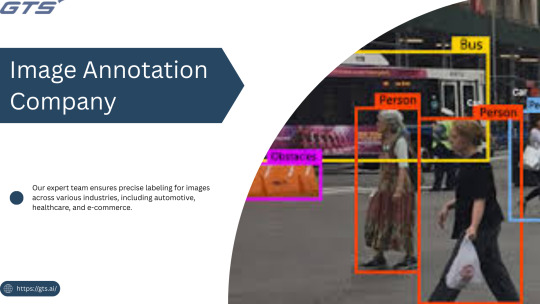
Introduction
In the fast-paced realm of artificial intelligence, Image Annotation Company serve as the foundation for effective computer vision models. Whether you are creating a self-driving vehicle, an AI-driven medical diagnostic application, or a retail analytics solution, the availability of high-quality annotated images is crucial for training precise and dependable machine learning models. But what precisely are image annotation services, how do they function, and what tools and methodologies are utilized? Let us explore this in detail.
What Is Image Annotation?
Image annotation refers to the practice of labeling or tagging images to facilitate the training of machine learning and deep learning models. This process includes the identification of objects, boundaries, and features within images, enabling AI systems to learn to recognize these elements in real-world applications. Typically, this task is carried out by specialized image annotation firms that employ a combination of manual and automated tools to guarantee precision, consistency, and scalability.
Common Image Annotation Techniques
The appropriate annotation method is contingent upon the specific requirements, complexity, and nature of the data involved in your project. Among the most prevalent techniques are:
Bounding Boxes:
Utilized for identifying and localizing objects by encasing them in rectangular boxes, this method is frequently applied in object detection for autonomous vehicles and security systems.
Polygon Annotation:
Best suited for objects with irregular shapes, such as trees, buildings, or road signs, this technique allows for precise delineation of object edges, which is essential for detailed recognition tasks.
Semantic Segmentation:
This approach assigns a label to every pixel in an image according to the object class, commonly employed in medical imaging, robotics, and augmented/virtual reality environments.
Instance Segmentation:
An advancement over semantic segmentation, this method distinguishes between individual objects of the same class, such as recognizing multiple individuals in a crowd.
Keypoint Annotation:
This technique involves marking specific points on objects and is often used in facial recognition, human pose estimation, and gesture tracking.
3D Cuboids:
This method enhances depth perception in annotation by creating three-dimensional representations, which is vital for applications like autonomous navigation and augmented reality.
Popular Image Annotation Tools
Image annotation can be executed utilizing a diverse array of platforms and tools. Notable examples include:
LabelImg: An open-source tool designed for bounding box annotations,
CVAT: A web-based application created by Intel for intricate tasks such as segmentation and tracking,
SuperAnnotate: A robust tool that merges annotation and collaboration functionalities,
Labelbox: A comprehensive platform featuring AI-assisted labeling, data management, and analytics,
VGG Image Annotator (VIA): A lightweight tool developed by Oxford for efficient annotations.
Prominent annotation service providers like GTS.AI frequently employ a blend of proprietary tools and enterprise solutions, seamlessly integrated with quality assurance workflows to fulfill client-specific needs.
Real-World Use Cases of Image Annotation
Image annotation services play a vital role in various sectors, including:
Autonomous Vehicles
Object detection for identifying pedestrians, vehicles, traffic signs, and road markings.
Lane detection and semantic segmentation to facilitate real-time navigation.
Healthcare
Annotating medical images such as X-rays and MRIs to identify tumors, fractures, or other abnormalities.
Training diagnostic tools to enhance early disease detection.
Retail and E-commerce:
Implementing product identification and classification for effective inventory management.
Monitoring customer behavior through in-store camera analytics.
Agriculture:
Assessing crop health, detecting pests, and identifying weeds using drone imagery.
Forecasting yield and optimizing resource allocation.
Geospatial Intelligence:
Classifying land use and mapping infrastructure.
Utilizing annotated satellite imagery for disaster response.
Why Work with a Professional Image Annotation Company?
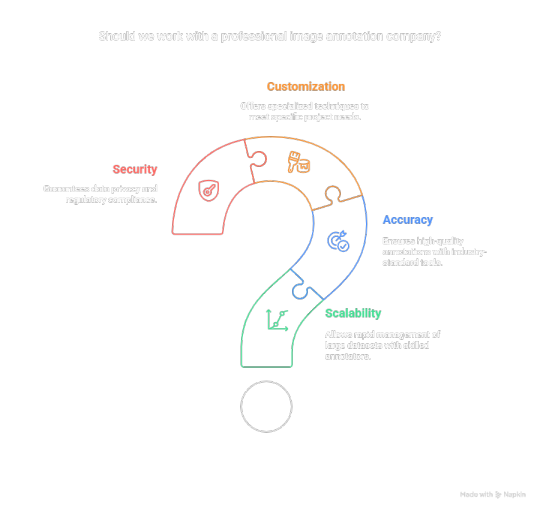
Although in-house annotation may initially appear feasible, expanding it necessitates significant time, resources, and a comprehensive quality assurance process. This is the reason businesses collaborate with providers such as GTS.AI:
Scalability : Allows for the rapid management of extensive datasets through skilled annotators;
Accuracy : Is ensured with industry-standard tools and quality assurance measures;
Customization : Coffers specialized annotation techniques to meet specific project objectives; and
Security : Guarantees adherence to data privacy regulations for sensitive data.
Final Thoughts
With the expansion of AI and computer vision applications, the necessity for high-quality annotated data has become increasingly vital. Image annotation services have evolved from being merely supportive functions to becoming strategic assets essential for developing dependable AI systems. If you aim to enhance your AI projects through professional data labeling, consider Globose Technology Solution .AI’s Image and Video Annotation Services to discover how they can effectively assist you in achieving your objectives with accuracy, efficiency, and scalability.
0 notes
Text
Affordable Video Data Collection Services for Computer Vision Projects
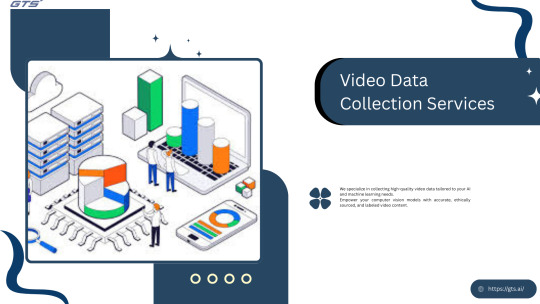
Introduction
Access Scalable and Cost-Effective Data for Enhanced AI Solutions. Explore Our Service Page →
As artificial intelligence transforms various sectors, the need for high-quality Video Data Collection to train computer vision models is at an all-time high. Whether you are working on autonomous vehicles, facial recognition technologies, or retail analytics applications, it is evident that the quality of your model is directly linked to the quality of your dataset.
However, the process of collecting video data poses significant challenges—it is often time-intensive, resource-demanding, and can incur substantial costs. This is where GTS’s Video Dataset Collection services, which are both affordable and scalable, come into play.
Why Video Data Matters in Computer Vision
Computer vision algorithms necessitate a variety of well-annotated datasets to effectively analyze the environment. In contrast to still images, video offers context, movement, and sequence—elements essential for tasks including:
Human activity recognition,
Object tracking,
Gesture detection,
Scene comprehension
Behavior forecasting.
Nevertheless, gathering such data on a large scale—while guaranteeing ethical sourcing and accurate annotation—presents a significant challenge.
The Hidden Costs of DIY Video Data Collection
If you have ever engaged in internal video data collection, you are likely aware of the obstacles involved:
Equipment and setup expenses,
The need to recruit a diverse range of participants,
The burden of annotation,
The labor-intensive nature of compliance and privacy management
And the variability in data quality.
These issues can rapidly deplete your financial resources and extend your project timeline.
GTS: Affordable Video Data Collection Done RightGTS: Affordable Video Data Collection Done Right
At GTS.ai, we provide affordable video data collection services while maintaining high standards of quality and compliance. Here’s how we manage to keep expenses down while achieving enterprise-level outcomes:
Global Workforce, Local Insight
We leverage a worldwide network of contributors to collect real-world data across various geographies, demographics, and use cases—on a large scale.
Customizable Collection Protocols
Whether your project requires outdoor pedestrian footage, in-vehicle driver behavior, or smart home interactions, we customize the data collection process to meet your specific requirements.
High-Quality Annotation
By integrating automation with human oversight, we ensure that each frame is accurately labeled, expediting your model training without inflating costs.
Compliance & Privacy First
Our processes adhere to GDPR and CCPA regulations, incorporating full consent protocols and secure data management.
Transparent Pricing
We offer straightforward, upfront pricing with no hidden charges—facilitating easier planning and scaling of your computer vision projects.
Use Cases We Support
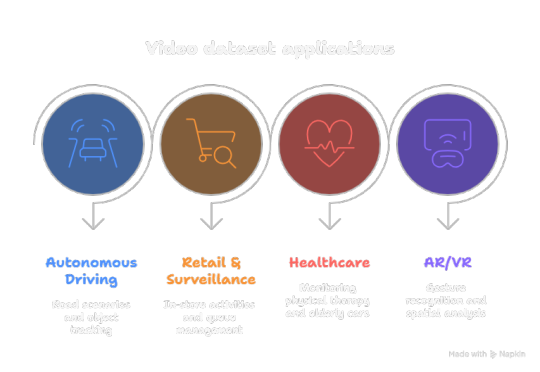
We offer cost-effective video datasets suitable for various applications, including:
Autonomous Driving – road scenarios, object tracking, and lane detection;
Retail & Surveillance – in-store activities, queue management, and loss prevention;
Healthcare – monitoring physical therapy and tracking elderly care behaviors;
AR/VR – gesture recognition and spatial interaction analysis.
Get Started Today
Do not allow data expenses to hinder your innovation. With Globose Technology Solution.ai, you can obtain cost-effective, high-quality video datasets that enhance the performance of your computer vision models more efficiently.
Discover our Video Dataset Collection Services and request a personalized quote today.
0 notes
Text
Best Image Annotation Companies Compared: Features, Pricing, and Accuracy

Introduction
As applications powered by artificial intelligence, such as self-driving cars, healthcare diagnostics, and online retail, expand, image annotation has emerged as a crucial component in developing effective machine learning models. However, with numerous providers offering annotation services, how can one select the most suitable Image Annotation Companies for their requirements? In this article, we evaluate several leading image annotation companies in 2025, considering their features, pricing, and accuracy, to assist you in identifying the best match for your project.
1. GTS.AI – Enterprise-Grade Accuracy with Custom Workflows
GTS.AI is renowned for its flexible annotation pipelines, stringent enterprise security standards, and its ability to cater to various sectors such as the automotive, healthcare, and retail industries.
Key Features:
Supports various annotation types including bounding boxes, polygons, keypoints, segmentation, and video annotation.
Offers a scalable workforce that includes human validation.
Integrates seamlessly with major machine learning tools.
Adheres to ISO-compliant data security protocols.
Pricing:
Custom pricing is determined based on the volume of data, type of annotation, and required turnaround time.
Offers competitive rates for datasets requiring high accuracy.
Accuracy:
Achieves over 98% annotation accuracy through a multi-stage quality control process.
Provides annotator training programs and conducts regular audits.
Best for: Companies in need of scalable, highly accurate annotation services across various industries.
2. Labelbox – Platform Flexibility and AI-Assisted Tools
Labelbox provides a robust platform for teams seeking to manage their annotation processes effectively, featuring capabilities that cater to both internal teams and external outsourcing.
Key Features
Include a powerful data labeling user interface and software development kits,
Automation through model-assisted labeling,
Seamless integration with cloud storage and machine learning workflows.
Pricing
Options consist of a freemium tier,
Custom pricing for enterprises,
Pay-per-usage model for annotations.
Accuracy
May vary based on whether annotators are in-house or outsourced, with strong quality
Control tools that necessitate internal supervision.
This platform is ideal for machine learning teams in need of versatile labeling tools and integration possibilities.
3. Scale AI – Enterprise-Level Services for Complex Use Cases
Scale AI is a leading provider in the market for extensive and complex annotation tasks, such as 3D perception, LiDAR, and autonomous vehicle data.
Key Features:
Offers a wide range of annotation types, including 3D sensor data.
Utilizes an API-first platform that integrates with machine learning.
Provides dedicated project managers for large clients.
Pricing
Premium pricing, particularly for high-complexity data.
Offers project-based quotes.
Accuracy:
Renowned for top-tier annotation accuracy.
Implements multi-layered quality checks and human review.
Best for: Projects in autonomous driving, defense, and robotics that require precision and scale.
4. CloudFactory – Human-Centric Approach with Ethical Sourcing
CloudFactory offers a unique blend of skilled human annotators and ethical AI practices, positioning itself as an excellent choice for companies prioritizing fair labor practices and high data quality.
Key Features:
The workforce is trained according to industry-specific guidelines.
It supports annotation for images, videos, audio, and documents.
There's a strong focus on data ethics and the welfare of the workforce.
Pricing
Pricing is based on volume and is moderately priced compared to other providers.
Contracts are transparent.
Accuracy
There are multiple stages of human review.
Continuous training and feedback loops are implemented.
Best for: Companies looking for socially responsible and high-quality annotation services.
5. Appen – Global Crowd with AI Integration

Appen boasts one of the largest international crowds for data annotation, offering extensive support for various AI training data types, such as natural language processing and computer vision.
Key Features
Include a diverse global crowd with multilingual capabilities,
Automated workflows, and data validation tools,
As well as high data throughput suitable for large-scale projects.
Pricing
Appen provides competitive rates for bulk annotation tasks,
With options for pay-as-you-go and contract models.
Accuracy
The quality of data can fluctuate based on project management,
Although the workflows are robust, necessitating a quality control setup.
Best for: This service is ideal for global brands and research teams that need support across multiple languages and domains.
Conclusion: Choosing the Right Partner
The ideal image annotation company for your project is contingent upon your specific requirements:
If you require enterprise-level quality with adaptable services, Globose Technology Solution.AI is recommended.
For those seeking comprehensive control over labeling processes, Labelbox is an excellent choice.
If your project involves intricate 3D or autonomous data, Scale AI is specifically designed for such tasks.
If ethical sourcing and transparency are priorities, CloudFactory should be considered.
For multilingual and scalable teams, Appen may be the right fit.
Prior to selecting a vendor, it is essential to assess your project's scale, data type, necessary accuracy, and compliance requirements. A strategic partner will not only assist in labeling your data but also enhance your entire AI development pipeline.
0 notes
Text
Top Video Data Collection Services for AI and Machine Learning
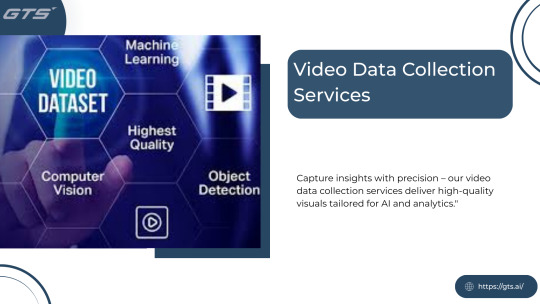
Introduction
In the contemporary landscape dominated by artificial intelligence, video data is essential for the training and enhancement of machine learning models, particularly in fields such as computer vision, autonomous systems, surveillance, and retail analytics. However, obtaining high-quality video data is not a spontaneous occurrence; it necessitates meticulous planning, collection, and annotation. This is where specialized Video Data Collection Services become crucial. In this article, we will examine the characteristics that define an effective video data collection service and showcase how companies like GTS.AI are establishing new benchmarks in this industry.
Why Video Data Is Crucial for AI Models
Video data provides comprehensive and dynamic insights that surpass the capabilities of static images or text. It aids machine learning models in recognizing movement and patterns in real time, understanding object behavior and interactions, and enhancing temporal decision-making in complex environments. Video datasets are essential for various real-world AI applications, including the training of self-driving vehicles, the advancement of smart surveillance systems, and the improvement of gesture recognition in augmented and virtual reality.
What to Look for in a Video Data Collection Service
When assessing a service provider for the collection of video datasets, it is essential to take into account the following critical factors:
Varied Environmental Capture
Your models must be able to generalize across different lighting conditions, geographical locations, weather variations, and more. The most reputable providers offer global crowd-sourced collection or customized video capture designed for specific environments.
2. High-Quality, Real-Time Capture
Quality is paramount. Seek services that provide 4K or HD capture, high frame rates, and various camera angles to replicate real-world situations.
3. Privacy Compliance
In light of the growing number of regulations such as GDPR and HIPAA, it is imperative to implement measures for face and license plate blurring, consent tracking, and secure data management.
Annotation and Metadata
Raw footage alone is insufficient. The most reputable providers offer annotated datasets that include bounding boxes, object tracking, activity tagging, and additional features necessary for training supervised learning models.
Scalability
Regardless of whether your requirement is for 100 or 100,000 videos, the provider must possess the capability to scale efficiently without sacrificing quality.
GTS.AI: A Leader in Video Data Collection Services
At GTS.AI, we focus on delivering tailored, scalable, and premium video dataset solutions for AI and ML teams across various sectors.
What Sets GTS.AI Apart?
Our unique advantages include a global reach through a crowdsource network in over 100 countries, enabling diverse data collection.
We offer flexible video types, accommodating indoor retail and outdoor traffic scenarios with scripted, semi-scripted, and natural video capture tailored to client needs.
Our compliance-first approach ensures data privacy through anonymization techniques and adherence to regulations.
Additionally, we provide an end-to-end workflow that includes comprehensive video annotation services such as frame-by-frame labeling, object tracking, and scene segmentation.
For those requiring quick access to data, our systems are designed for rapid deployment and delivery while maintaining high quality.
Use Cases We Support
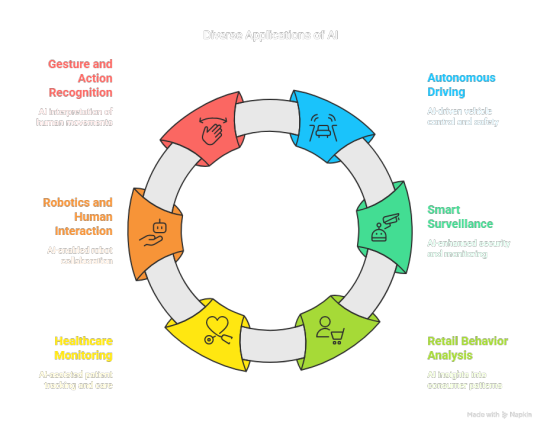
Autonomous Driving and Advanced Driver Assistance Systems,
Smart Surveillance and Security Analytics,
Retail Behavior Analysis,
Healthcare Monitoring such as Patient Movement Tracking,
Robotics and Human Interaction,
Gesture and Action Recognition.
Ready to Power Your AI Model with High-Quality Video Data?
Regardless of whether you are developing next-generation autonomous systems or creating advanced security solutions, Globose Technology Solution .AI's video data collection services can provide precisely what you require—efficiently, rapidly, and with accuracy.
0 notes
Text
What Is an Image Annotation Company and Why You Need One
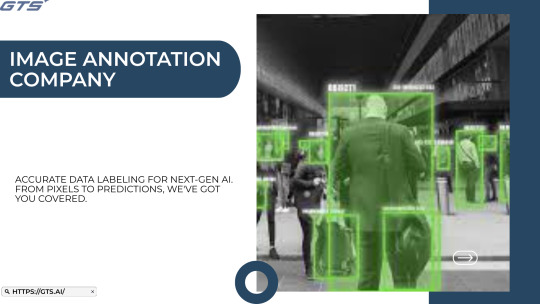
Introduction
In the era of artificial intelligence (AI), data has become the new oil; however, unprocessed data by itself will not yield effective outcomes. It requires refinement, organization, and labeling to gain value. This is where image annotation firms are crucial. Whether you are developing a self-driving vehicle to identify pedestrians, assisting a medical AI in tumor detection, or enhancing facial recognition technologies, accurately annotated images are necessary. Let us explore the functions of an Image Annotation Company and the importance of collaborating with one for achieving success in AI.
What Is Image Annotation?
Image annotation involves the labeling of images with pertinent metadata to enhance their comprehensibility for machine learning algorithms. This may include tasks such as drawing bounding boxes around vehicles, delineating organs in medical imaging, pinpointing key positions in human movement, or segmenting objects at the pixel level. These annotations enable AI models to 'perceive' and interpret the visual environment with precision, akin to the way humans utilize their eyes and cognitive processes.
What Does an Image Annotation Company Do?
A company specializing in image annotation offers expert services to accurately and consistently label large quantities of images and videos. They utilize skilled human annotators, AI-enhanced tools, and stringent quality assurance measures to produce labeled datasets customized for particular AI applications.
The services generally encompass: bounding box annotation,
polygon and polyline annotation,
semantic and instance segmentation,
3D point cloud labeling,
video frame annotation,
and keypoint and landmark detection.
Organizations such as GTS.AI provide comprehensive image and video annotation services to enhance AI training across various sectors.
Why You Need an Image Annotation Company
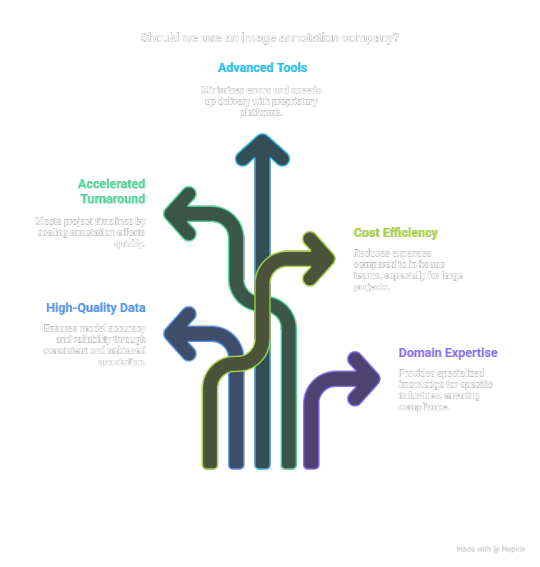
When developing AI or machine learning models that utilize visual data, annotation is not merely an option — it is a necessity. Here are the reasons why collaborating with a specialized company is crucial:
High-Quality, Consistent Data
The precision of your model is contingent upon the quality of your training data. Skilled annotators guarantee consistency and mitigate bias, leading to more dependable AI systems.
Accelerated Turnaround at Scale
Labeling thousands (or millions) of images internally is labor-intensive and time-consuming. Image annotation firms can rapidly scale their efforts to adhere to stringent project timelines.
3. Advanced Tools & Infrastructure
Professional organizations employ proprietary platforms equipped with automation capabilities, quality assurance measures, and data protection — all of which minimize errors and expedite delivery.
Cost Efficiency
Establishing an in-house annotation team can incur significant expenses. Outsourcing to a specialized partner frequently proves to be more effective, particularly for large-scale or ongoing initiatives.
Domain-Specific Expertise
Sectors such as healthcare, autonomous vehicles, and retail often necessitate specialized knowledge for annotation. A professional image annotation company provides that domain expertise, ensuring precision and compliance.
The Bottom Line
When investing in computer vision or AI development, the quality of your training data is crucial to your success. A dependable image annotation company offers the necessary tools, expertise, and technology to efficiently and accurately prepare your data. If you seek a reliable partner for your image and video annotation requirements, consider our services at Globose Technology Solution .AI to discover how we facilitate data labeling on a large scale across various industries, use cases, and technologies.
0 notes
Text
Enhancing Vehicle Detection with Bicycle Image Datasets

Introduction
In the dynamic field of artificial intelligence and computer vision, the detection of vehicles is essential for numerous applications such as traffic surveillance, autonomous vehicle operation, and smart city initiatives. Although there is an abundance of datasets containing images of cars, trucks, and motorcycles, the emergence of Bicycle Image Dataset Vehicle Detection has proven to be a significant asset in enhancing the precision and effectiveness of vehicle detection systems.
Why Bicycle Image Datasets Matter
Bicycles play a crucial role in both urban and rural transportation systems. Nevertheless, accurately identifying bicycles in mixed traffic environments poses significant challenges due to their diverse shapes, sizes, and movements. The integration of bicycle image datasets into vehicle detection models offers several benefits:
Increased Model Precision: Training models with images of bicycles enhances their ability to distinguish between bicycles and other vehicles with greater accuracy.
Improved Safety for Cyclists in Autonomous Vehicles: Effective detection of bicycles minimizes the likelihood of accidents involving cyclists.
Enhanced Traffic Flow Assessment: Urban planners and traffic management systems gain access to more detailed data when bicycles are incorporated into vehicle detection models.
Decreased Instances of False Positives and Negatives: Many current models incorrectly classify bicycles as either pedestrians or motorcycles; utilizing a specialized dataset can help rectify these inaccuracies.
Key Features of a Bicycle Image Dataset
A comprehensive bicycle image dataset ought to encompass the following elements:
Varied Environments: Incorporating urban, suburban, and rural landscapes.
Multiple Perspectives and Lighting Conditions: To guarantee resilience in real-world applications.
Labeled Data: Including bounding boxes, segmentation masks, or keypoints to improve model training.
Diverse Bicycle Models and Riders: Featuring road bikes, mountain bikes, electric bikes, and a range of rider positions.
Applications of Bicycle Image Datasets in Vehicle Detection
Autonomous Driving
Self-driving vehicles depend on precise object recognition to ensure safe navigation. Datasets containing images of bicycles assist AI systems in differentiating bicycles from other road users, thereby minimizing the likelihood of collisions.
Traffic Surveillance & Smart Cities
AI-powered cameras in traffic monitoring systems are employed to observe vehicle movements. The incorporation of bicycle image datasets improves their capacity to identify and assess trends in bicycle traffic.
Enhancing Current Vehicle Detection Models
Many vehicle detection systems primarily target cars and motorcycles, which can result in errors when bicycles are involved. The integration of bicycle image datasets contributes to the balance and enhancement of these detection models.
How to Use the Bicycle Image Dataset for Training

Acquire the Dataset: Obtain a well-organized dataset through the Globose Technology Solution.
Prepare the Images: Adjust the size, normalize, and augment the images to enhance the training process.
Implement Advanced Annotation Methods: Utilize techniques such as bounding boxes, segmentation, or keypoints to improve the learning experience.
Develop a Deep Learning Model: Employ architectures such as YOLO, Faster R-CNN, or SSD for bicycle detection.
Assess and Enhance: Regularly improve the model by evaluating its performance in real-world situations.
Conclusion
Bicycle image datasets play a vital role in the development of precise and dependable vehicle detection systems. These datasets are invaluable for applications such as autonomous driving, smart city development, and AI-driven traffic monitoring, as they offer essential information that improves both safety and operational efficiency. By integrating bicycle images into training models, we can create more comprehensive and advanced vehicle detection solutions.
To access a high-quality dataset, please follow this link and begin improving your vehicle detection models today!
0 notes
Text
Creating and Annotating a Linear Equation Image Dataset for Machine Learning
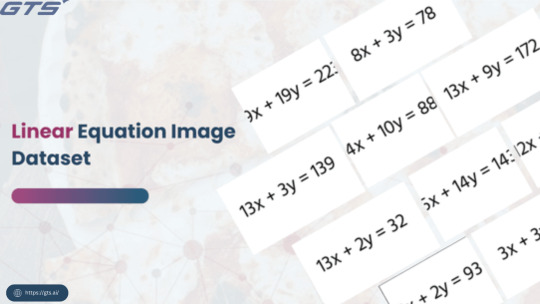
Introduction
In the dynamic field of machine learning, datasets are essential for training models to identify patterns, categorize images, and generate predictions. A notable example of a valuable dataset in both educational and AI research settings is the Linear Equation Image Dataset. This dataset comprises visual depictions of linear equations, allowing models to effectively interpret and analyze mathematical expressions.
In this article, we will examine the steps involved in creating and annotating a Linear Equation Image Dataset, as well as its applications in machine learning.
Why a Linear Equation Image Dataset?
A Linear Equation Image Dataset offers numerous advantages:
Recognition of Handwriting: Facilitating the training of Optical Character Recognition (OCR) models to identify handwritten linear equations.
Applications in Mathematical Education: Aiding students in visually comprehending linear equations.
AI-Driven Equation Solvers: Creating machine learning models that can autonomously read and solve equations.
Recognition of Patterns: Improving the capability of artificial intelligence to interpret mathematical symbols and their interrelations.
Steps to Create a Linear Equation Image Dataset
Establish the Scope and Data Requirements
Prior to creating the dataset, it is essential to identify:
The specific types of linear equations to be included (for instance, slope-intercept form or standard form).
The choice between utilizing handwritten equations, digitally generated images, or a combination of both.
The necessary size of the dataset to ensure effective training.
Creating Images of Linear Equations
There are several methods to produce images of linear equations:
Programmatic Generation: Employing Python libraries such as Matplotlib or PIL to generate equations in image format.
Handwritten Samples: Gathering handwritten equations from various individuals to enhance generalization.
Typesetting with LaTeX: Utilizing LaTeX to render equations and subsequently converting them into images.
Image Annotation and Labeling
For machine learning models to learn efficiently, it is crucial to annotate each image with pertinent metadata. This should include:
Equation Text: The mathematical expression presented in either LaTeX or plaintext format.
Graph Representation: The associated graph, if relevant.
Bounding Boxes: For training an OCR model, delineating areas where specific components of the equation are located.
Equation Type: Classifying images according to their equation format (e.g., y = mx + b, Ax + By = C).
Applications such as LabelImg and Roboflow are useful for performing manual annotation tasks.
Dataset Storage and Formatting
The dataset must be organized in a systematic manner:
Images should be saved in PNG or JPEG formats.
Annotations must be provided in CSV, JSON, or XML formats, accompanied by the relevant labels.
A structured directory should be established to categorize various types of equations.
Dataset Augmentation
To enhance the model's resilience, various augmentation methods can be utilized:
Rotation and Scaling: Apply minor adjustments in orientation.
Noise Addition: Simulate real-world distortions.
Color Variations: Adapt the dataset to account for different lighting scenarios.
Handwritten Variability: Introduce diversity by incorporating various handwriting styles.
Download the Linear Equation Image Dataset
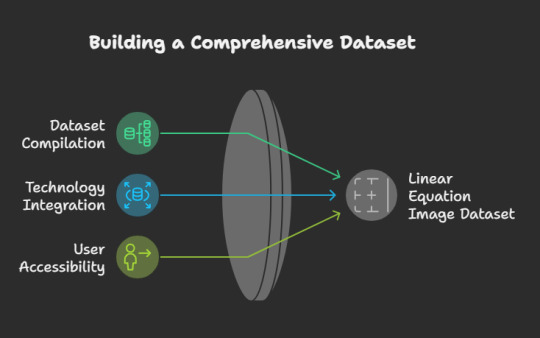
To expedite your work, you may download a pre-assembled Linear Equation Image Dataset for your projects. Please follow the link below to access the dataset: Globose Technology Solution
Conclusion
Developing and annotating a Linear Equation Image Dataset is an essential phase in training artificial intelligence models for mathematical comprehension. By adhering to a systematic methodology, you can create a dataset that serves various purposes, including optical character recognition (OCR), educational tools, and AI-enhanced problem-solving applications. Regardless of whether you create your own dataset or utilize an existing one, ensuring that the dataset is meticulously labeled is vital for obtaining precise outcomes in machine learning.
Are you engaged in a project that necessitates a Linear Equation Image Dataset? We invite you to share your insights in the comments section below!
0 notes
Text
Analyzing the Khaadi Fashion Dataset: Trends & Insights

Introduction
The fashion industry is characterized by its ever-changing nature, influenced by consumer tastes, cultural factors, and seasonal variations. As data-driven decision-making gains prominence, the analysis of fashion datasets has become essential for brands seeking to comprehend market trends and consumer behaviors. A notable resource in this context is the Khaadi Fashion Dataset, which offers in-depth insights into the prevailing patterns, designs, and color schemes within the fashion sector. This blog will delve into the significant findings from the dataset and discuss how these insights can be utilized to inform business and design strategies.
Understanding the Khaadi Fashion Dataset
The Khaadi Fashion Dataset, accessible through GTS AI, comprises an extensive array of fashion-related information, which includes:
Product categories such as kurtas, shawls, trousers, and accessories
Types of fabrics like cotton, lawn, silk, and chiffon
Variations in color
Design motifs including floral, geometric, and abstract patterns
Price ranges
Seasonal collections
Through the analysis of this dataset, businesses and fashion designers can uncover consumer preferences, forecast future trends, and enhance their inventory management.
Key Trends Identified
Prevailing Color Trends
Analysis of the dataset indicates that certain colors consistently excel across various collections. Pastel tones, earthy shades, and vibrant colors such as deep blue and maroon are regularly highlighted, reflecting consumer preferences for both versatile and striking color selections.
Preferred Fabric Selections
The data indicates that cotton and lawn are the most popular fabric choices, particularly in the summer months. In contrast, silk and chiffon are favored for formal attire, underscoring the influence of seasonal and occasion-driven buying behaviors.
Prominent Design Motifs
Khaadi’s collections are characterized by a prevalence of floral and geometric patterns, which underscore their enduring appeal. Furthermore, abstract designs have become increasingly popular in recent years, indicating a trend towards contemporary aesthetics.
Seasonal Trends and Demand Projections
The dataset reveals a significant increase in demand during Eid and wedding seasons, during which luxury collections experience heightened sales. Brands can utilize this information to implement targeted marketing strategies and refine their production timelines.
How Businesses Can Utilize These Insights

Customized Marketing Approaches
Retailers can leverage data analytics to provide recommendations that reflect previous purchases, thereby creating a more personalized shopping experience for customers.
Streamlining Inventory Management
By pinpointing the most popular fabrics, colors, and designs, companies can refine their inventory, decreasing overproduction and minimizing financial losses.
AI-Driven Fashion Trend Prediction
Machine learning algorithms can forecast future fashion trends by analyzing historical data, enabling brands to remain proactive in response to market changes.
Improving Customer Engagement
Through the examination of consumer preferences, brands can develop more captivating shopping experiences, ranging from AI-enhanced virtual try-ons to data-informed product launches.
Conclusion
The Khaadi Fashion Dataset is an essential resource for businesses and designers seeking to thrive in the dynamic fashion industry. By utilizing data insights, brands can make strategic decisions, improve customer engagement, and maintain a competitive edge in the fashion marketplace.
To access the dataset, please visit Globose Technology Solution AI and harness the potential of data-driven fashion analytics.
0 notes
Text
Mastering the Spanish Sign Language Alphabet: A Beginner’s Guide

Introduction
Acquiring proficiency in the Spanish Sign Language Alphabet (Lengua de Señas Española, or LSE) is an important skill for effective communication with the Deaf community in Spanish-speaking areas. This knowledge is beneficial for beginners, language lovers, and individuals engaged in inclusive settings, as mastering fingerspelling in LSE is a crucial milestone.
This guide will explore the fundamentals of the Spanish Sign Language Alphabet, its significance, and provide you with steps to begin your learning journey today.
Why Learn the Spanish Sign Language Alphabet?
Enhances Communication: Acquiring knowledge of LSE enables more effective engagement with the Deaf community.
Strengthens Cognitive Abilities: Mastery of sign language contributes to improved memory, spatial awareness, and the capacity to multitask.
Broadens Cultural Understanding: Gaining proficiency in sign language fosters inclusivity and a deeper appreciation for Deaf culture.
Career Advancement: Proficiency in sign language is highly regarded in various fields, including education, healthcare, and customer service.
Understanding the Spanish Sign Language Alphabet (LSE)
The Spanish Sign Language Alphabet comprises manual signs that correspond to each letter of the Spanish alphabet. These gestures facilitate the spelling of words, names, and unfamiliar terms. In contrast to certain other sign languages, LSE exhibits regional variations.
Notable Distinctions from American Sign Language (ASL)
LSE is predominantly utilized in Spain, whereas ASL is employed in the United States.
The signs for the alphabet in LSE differ from those in ASL, despite both languages incorporating fingerspelling.
LSE includes specific gestures for letters that feature accents, such as ñ.
How to Learn the Spanish Sign Language Alphabet
Obtain a Visual Reference
A practical approach to begin is by utilizing a chart of the Spanish Sign Language Alphabet. You can access one for download here: Spanish Sign Language Alphabet Chart.
Engage in Daily Fingerspelling Practice
Commence by practicing the letters in front of a mirror. Spell your name, frequently used words, or locations. Gradually challenge yourself to enhance both speed and accuracy.
View Instructional Videos
Visual learning plays a crucial role in mastering sign language. Seek out video tutorials where native signers illustrate each letter.
Participate in a Sign Language Community
Engaging with individuals who are either learning or proficient in LSE can greatly enhance your abilities. Look for online forums or local gatherings to practice.
Utilize Flashcards and Sign Language Applications
Numerous mobile applications and flashcards are available to support your learning through repetition and interactive games.
Tips for Effective Learning

Consistency is essential: Engaging in daily practice, even in small amounts, will strengthen memory retention.
Utilize both hands when needed: Certain letters may necessitate the use of both hands.
Be mindful of hand positioning: The orientation of your palm is significant in sign language.
Embrace the possibility of errors: Acquiring a new language requires both practice and perseverance.
Conclusion
Gaining expertise in the Spanish Sign Language Alphabet is an important ability that promotes inclusivity and improves communication. By following the steps outlined in this guide, you will embark on the journey to mastering fingerspelling and engaging with the Deaf community in Spain and beyond.
Are you ready to get started? Download the Spanish Sign Language Alphabet chart and commence your practice today!
Presented by Globose Technology Solution.
0 notes
Text
Exploring the Beauty of Ornamental Flower Plants: A Comprehensive Dataset

Introduction
Gardening and horticulture have historically been valued as avenues for connecting with the natural world, enhancing the aesthetic appeal of environments, and showcasing individual creativity. Among the most intriguing aspects of gardening are ornamental flower plants. These blooms not only introduce a spectrum of colors and delightful scents but also carry symbolic meanings and cultural significance worldwide. In contemporary times, the integration of technology and data has provided new opportunities for gardeners, researchers, and horticulturists, allowing for a more systematic exploration of the rich diversity found in ornamental flowers.
In this blog, we will explore the allure of Ornamental Flower Plants Datasets through the analysis of a detailed dataset. By leveraging this information, we can uncover fresh insights, improve garden designs, and gain a deeper understanding of the various types of ornamental flowers. Whether you are an experienced horticulturist or a novice gardener, recognizing the patterns and trends embedded within this data can assist you in cultivating more vibrant and sustainable green spaces.
What Are Ornamental Flower Plants?
Ornamental flowering plants are cultivated primarily for their visual attractiveness. These species are selected based on their aesthetic qualities—such as vivid colors, distinctive forms, delightful fragrances, and intricate designs—which render them suitable for decorative applications in gardens, residences, public areas, and landscapes. In contrast to plants that are grown for culinary, medicinal, or industrial purposes, ornamental flowers offer solely aesthetic advantages.
Notable examples of ornamental flowering plants include roses, tulips, daisies, lilies, petunias, and geraniums. These flowers are valued for their diverse array of colors, shapes, and blooming periods, making them excellent selections for gardeners who wish to establish a visually appealing and captivating garden setting.
Why Explore an Ornamental Flower Plants Dataset?
In the era of extensive data collection, a comprehensive dataset containing intricate details about ornamental flower plants can be an invaluable asset for various applications:
Garden Design and Landscaping: By examining the dataset, horticulturists can select flowers based on attributes such as color, blooming season, and growth patterns. This facilitates the development of aesthetically pleasing and sustainable flower beds and landscapes.
Flower Identification and Classification: For botanists and flower aficionados, such datasets can aid in the identification and classification of diverse ornamental flowers based on characteristics like leaf morphology, flower structure, or natural habitat. This simplifies the process of recognizing plants and their varieties, even in their natural environments.
Predicting Growth Patterns: Insights into factors such as sunlight exposure, temperature, soil composition, and moisture needs derived from the dataset can assist in forecasting how various flowers will flourish in particular locales. This information is crucial for gardeners aiming to make informed, data-driven choices regarding plant care and positioning.
Conservation Initiatives: Ornamental flowers are vital to local ecosystems, attracting pollinators such as bees, butterflies, and birds. By analyzing these datasets, conservationists can investigate the distribution of specific species and monitor changes in plant populations, thereby aiding in the preservation of threatened flower varieties.
Promoting Sustainability: Data can highlight trends related to drought-resistant or pest-resistant ornamental flower species, promoting the adoption of these varieties in both urban and rural landscaping endeavors to foster more sustainable and environmentally friendly spaces.
A Look at the Ornamental Flower Plants Dataset
The Ornamental Flower Plants Dataset serves as an extensive resource that offers in-depth information on a diverse array of ornamental flower species. This dataset encompasses various attributes that assist users in comprehending different plant species, including:
Species Name: Both scientific and common names to facilitate plant identification.
Flower Color: Details regarding the color(s) of the flowers, a key aesthetic characteristic.
Blooming Season: Information on whether the plant flowers in spring, summer, fall, or winter.
Growth Requirements: Guidance on the necessary soil type, moisture levels, and sunlight exposure for the plant.
Height & Spread: Measurements of the plant’s potential height and width, crucial for effective garden space planning.
Foliage Type: Insights into whether the plant possesses evergreen or deciduous leaves.
Geographical Region: Information on the natural habitats of the plant species, shedding light on their preferred climatic conditions.
Pests & Diseases: Data on prevalent pests and diseases that may impact ornamental flowers, enabling gardeners to implement preventive strategies.
By analyzing these attributes, users can more effectively design their gardens and determine which plants are best suited for their specific environments. Additionally, the dataset can assist in identifying plants found in natural settings or botanical collections.
Benefits of Using Data-Driven Gardening Techniques
The integration of data into gardening practices has become increasingly accessible, particularly with resources such as the Ornamental Flower Plants Dataset. The following are several advantages of utilizing this data to enhance your gardening experience:
Customized Suggestions
Data empowers gardeners to receive personalized plant suggestions tailored to their geographical location, soil characteristics, and individual design preferences. Whether you aim to create a garden with a specific color palette or one that attracts pollinators, data can assist in selecting plants that are well-suited to your particular conditions.
Enhanced Decision-Making
Access to a dataset equips you with the necessary information to make educated choices regarding the plants you wish to cultivate, thereby minimizing the trial-and-error process. For instance, by analyzing the growth habits of different species, you can select plants that harmonize in size and flowering periods.
Improved Plant Maintenance
Insights derived from data regarding watering needs, sunlight requirements, and temperature tolerances can significantly enhance the care of your ornamental flowers. This approach promotes healthier plants that are more likely to bloom vibrantly and endure for extended periods.
Economical Gardening
Gardening expenses can accumulate quickly, particularly when investing in plants that fail to thrive. By leveraging datasets to comprehend plant needs and forecast potential results, you can conserve resources and reduce costs by opting for plants that are more likely to prosper in your garden.
How to Get Started with the Ornamental Flower Plants Dataset

If you are prepared to embark on a journey into the diverse realm of ornamental flower plants, the Ornamental Flower Plants Globose Technology Solution Dataset serves as an excellent starting point. By downloading this dataset, you can thoroughly investigate the attributes of various flower species, whether your aim is to design a new garden, examine trends in flower characteristics, or simply indulge your curiosity regarding the variety of ornamental plants.
For researchers and horticulturists, this dataset lays the groundwork for sophisticated analyses, including the development of machine learning models, plant classification, and studies on climate adaptation. For amateur gardeners, it offers a valuable resource for making informed decisions about which plants to cultivate based on their specific needs and preferences.
Conclusion
Ornamental flowering plants enhance the natural beauty, vibrancy, and vitality of our gardens and landscapes. Utilizing a comprehensive dataset allows for a deeper appreciation of these plants that transcends mere visual appeal. Data provides insights into the science of flower growth, distribution, and care, transforming gardening into a more knowledgeable, efficient, and fulfilling endeavor. Whether you are planning a flower bed, exploring biodiversity, or experimenting with garden layouts, the information derived from resources such as the Ornamental Flower Plants Dataset is indispensable.
Harness the potential of data to assist you in crafting your ideal garden, brimming with lively and stunning ornamental flowers. Wishing you a fruitful gardening experience.
0 notes
Text
Harnessing Drones for Waste Management: A Deep Dive into Garbage Detection Datasets

Introduction
The swift increase in urban populations, coupled with the corresponding surge in waste production, poses considerable challenges for cities and municipalities across the globe. While traditional waste management systems have proven effective in various respects, they frequently encounter limitations due to constraints in human resources, delayed response times, and inefficiencies in monitoring and collection processes. As urban areas continue to expand, the intricacies of their waste management systems also escalate, necessitating innovative approaches.
One promising solution involves the integration of Drone Garbage Detection Dataset technology with garbage detection datasets. This dynamic combination not only provides a more intelligent method for waste monitoring but also paves the way for a reimagined perspective on environmental management. In this blog, we will thoroughly examine the role of drones in waste management and investigate how garbage detection datasets are essential for realizing their full capabilities.
Why Drones for Waste Management?
Drones are rapidly emerging as one of the most efficient instruments in contemporary waste management. Their capability to navigate challenging terrains, deliver real-time surveillance, and cover extensive areas swiftly is transforming the processes of waste detection and management.
The significant influence of drones in this sector can be attributed to several factors:
Real-Time Surveillance: Drones are capable of capturing aerial images and video feeds, offering immediate data regarding waste accumulation across various locations, including hard-to-reach areas such as remote regions, informal settlements, or densely populated urban environments.
Enhanced Waste Detection: Fitted with high-resolution cameras and advanced sensors, drones can autonomously identify and categorize waste materials, such as plastic bottles, bags, and other refuse, thereby expediting the detection process compared to traditional manual methods.
Cost-Effective and Scalable Solutions: Drones diminish the reliance on extensive human resources, enabling municipalities to expand their waste management initiatives in a financially viable manner. Additionally, they reduce human exposure to hazardous waste sites.
Environmental Benefits: By facilitating accurate identification of waste hotspots, drones promote more sustainable waste management practices. They assist authorities in directing cleanup efforts to the most critical areas, thereby ensuring a cleaner environment and mitigating the risk of waste escalating into a larger environmental issue.
The Role of Garbage Detection Datasets
In order for drones to effectively identify waste, they must utilize comprehensive datasets for processing and analyzing visual information. This is where garbage detection datasets become crucial. These datasets play a vital role in training the artificial intelligence (AI) systems integrated into drones, allowing them to autonomously recognize and categorize various types of waste.
Typically, garbage detection datasets comprise high-resolution images and data that have been labeled with different categories of waste materials (such as plastic, paper, glass, and organic matter). These datasets enable machine learning models to acquire knowledge from the data, thereby enhancing the drone's capability to detect even minor or concealed waste items over time.
An illustrative example of such a resource is the Drone Garbage Detection Dataset provided by GTS.ai. This dataset is specifically tailored to facilitate the advancement of machine learning algorithms for waste detection via drones. It includes thousands of images annotated with diverse types of waste, which AI models leverage to accurately identify and classify objects in practical environments.
How Garbage Detection Datasets Improve Waste Management
Improving Detection Precision: The datasets utilized for training artificial intelligence models enable drones to identify and differentiate among various types of waste. For example, a proficiently trained drone can recognize the difference between a plastic bottle and a cardboard box, thereby assisting waste management teams in prioritizing which waste types require immediate intervention.
Automated Waste Classification: After capturing images, the AI systems process the data using the waste detection dataset to categorize the types of waste found in the environment. This automation significantly decreases the time allocated to manual sorting and enhances the operational efficiency of waste collection teams.
Predictive Analytics Capabilities: By examining historical data and waste accumulation trends, AI-powered drones can forecast locations where waste is likely to gather, providing waste management teams with critical insights for future focus areas. This predictive functionality further streamlines the waste management process, enabling proactive strategies instead of reactive responses.
Real-Time Monitoring and Reporting: Utilizing garbage detection datasets, drones can conduct real-time surveillance and produce comprehensive reports that track waste over time. This information is essential for municipalities to evaluate the effectiveness of their waste management practices and to identify areas that need increased attention.
Resource Efficiency: By delivering precise and current information, drones facilitate the efficient deployment of resources, such as collection vehicles and personnel. This optimization reduces the costs associated with waste management and contributes to more sustainable operations by minimizing the carbon footprint linked to unnecessary trips.
Challenges and Opportunities in Drone Garbage Detection
Drones possess significant potential in the realm of waste management; however, several challenges must be overcome prior to their complete integration into current waste management frameworks:
Meteorological and Environmental Factors: Drones frequently face limitations due to adverse weather conditions, such as heavy precipitation, fog, or high winds, which can hinder their operational capabilities and the accuracy of data collection.
Data Privacy and Security Concerns: The deployment of drones in waste management necessitates the gathering of extensive visual data, which may lead to concerns regarding privacy and security. It is essential to implement appropriate measures to ensure that data is managed ethically and in accordance with relevant regulations.
Seamless Integration with Current Systems: For drones to achieve their full potential, they must be able to integrate effectively with existing waste management systems, including waste collection logistics, municipal infrastructure, and AI-driven software platforms.
Notwithstanding these challenges, the potential benefits are substantial. As drone technology advances, the precision and functionality of waste detection datasets are expected to improve. With continuous progress, drones could emerge as a vital element in promoting sustainable urban development, environmental protection, and effective waste management.
The Future of Drone-Assisted Waste Management

The incorporation of drones with waste detection datasets marks a substantial advancement in the field of waste management. These technologies enable real-time monitoring of waste, automatic identification of various types of refuse, and the provision of valuable insights for improved resource distribution, positioning drones to transform the industry.
As urban areas globally seek more intelligent and sustainable waste management solutions, the roles of drone technology and machine learning are set to expand significantly. By utilizing drone waste detection datasets, local governments can enhance the effectiveness of their waste management operations while making significant strides toward achieving cleaner and more environmentally friendly cities.
Are You Ready to Leverage Drone Technology?
If you are keen on discovering how drones can improve waste management in your community, consider exploring the Drone Garbage Detection Dataset provided by GTS.ai. This resource will assist you in developing the AI models necessary for the effective and efficient detection and classification of waste.
Begin your journey today: Globose Technology Solution
With the appropriate datasets, the future of waste management is promising: cleaner urban environments, more intelligent systems, and a sustainable future for everyone.
Conclusion
Drones, in conjunction with waste detection datasets, are revolutionizing waste management methodologies. Their capacity to identify, categorize, and forecast waste locations through artificial intelligence is fundamentally changing the approach cities take towards waste disposal. By adopting this technology, we can enhance operational efficiency, minimize environmental repercussions, and foster cleaner, more sustainable urban settings. The potential is limitless—now is the moment to turn these possibilities into reality.
0 notes
Text
Cow Segmentation Dataset: A Vital Tool for Precision Livestock Farming

Introduction
In the era of digital transformation, the agricultural sector is progressively utilizing artificial intelligence (AI) to improve productivity and operational efficiency. A significant development in livestock management is the implementation of Cow Segmentation Dataset , which are essential for precision livestock farming. These datasets offer comprehensive annotations of cow images, allowing AI models to effectively identify, segment, and assess cattle under diverse conditions.
Why Cow Segmentation Matters
Cow segmentation refers to the technique of identifying and delineating individual cows within images or video frames. This technology has several applications in livestock management, including:
Health Monitoring: AI-driven segmentation facilitates the detection of irregularities such as weight loss, skin diseases, or unusual postures, enabling farmers to respond promptly.
Behavior Analysis: By segmenting cows in various settings, researchers can observe movement patterns, grazing behaviors, and social interactions.
Automated Counting: Traditional counting methods are often inaccurate. Automated segmentation ensures precise counting of cows on large farms, thereby conserving time and labor.
Precision Feeding: Gaining insights into individual cow metrics allows farmers to customize feeding strategies for enhanced nutrition and productivity.
Breeding Optimization: AI models developed using segmentation data can evaluate cow health and reproductive conditions, aiding in more informed breeding choices.
Applications of Cow Segmentation Dataset
A meticulously organized cow segmentation dataset serves as the cornerstone for training artificial intelligence models aimed at executing practical livestock management activities. Notable applications encompass:
Surveillance and Security: AI-enhanced farm surveillance systems can identify lost or wandering cows.
Automated Milking Systems: Accurate segmentation facilitates the proper positioning of cows for robotic milking processes.
Disease Prevention: Timely identification of ill cows mitigates the risk of disease spread and promotes the health of the herd.
Yield Prediction: AI-based analytics provide insights into milk production forecasts by considering factors such as cow size, breed, and health status.
Accessing a High-Quality Cow Segmentation Dataset
For researchers, developers, and agritech firms aiming to improve their AI models, acquiring a high-quality dataset is essential. The Cow Segmentation Dataset provided by GTS AI serves as an invaluable asset, featuring carefully labeled images of cows in various environments.
Key attributes of the GTS AI Cow Segmentation Dataset include:
High-resolution images with detailed pixel-level annotations
A variety of backgrounds and lighting scenarios
Inclusion of multiple cow breeds
Ground truth masks for accurate segmentation
A ready-to-use format suitable for machine learning applications.
Future of AI in Livestock Farming

As artificial intelligence progressively transforms the agricultural sector, the importance of cow segmentation datasets is poised to increase substantially. Enhanced deep learning models, coupled with more comprehensive datasets, will enable farmers to achieve greater efficiency, lower expenses, and better animal welfare. The integration of sophisticated AI technologies will facilitate the livestock industry’s transition to data-driven precision farming, paving the way for a sustainable and profitable future.
For individuals keen on investigating and applying AI-enhanced livestock solutions, the Globose Technology Solution AI Cow Segmentation Dataset serves as an excellent foundation. Download it today from here and embark on a journey to revolutionize contemporary farming practices.
Conclusion
The Cow Segmentation Dataset serves as a vital resource that extends beyond a mere assortment of images; it is an essential instrument propelling the advancement of intelligent agriculture. This dataset is invaluable for academic research, artificial intelligence development, and commercial uses, as utilizing high-quality datasets facilitates enhanced decision-making, greater efficiency, and superior livestock management. With artificial intelligence at the forefront, precision farming has transitioned from a theoretical concept to a concrete reality.
0 notes
Text
Exploring the Different Types of Indonesian Wayang
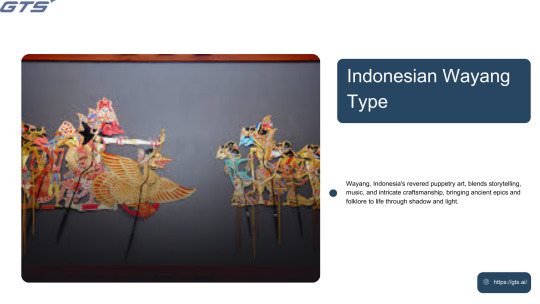
Introduction
Indonesian Wayang Type stands as one of the most esteemed traditional art forms in Southeast Asia. Deeply embedded in history and mythology, Wayang encompasses a style of puppetry and theatrical performance that has played an essential role in Indonesia’s cultural legacy for centuries. Featuring a diverse array of styles and materials in its execution, Wayang consistently enchants audiences through its narrative depth, exquisite craftsmanship, and spiritual importance. This article delves into the various types of Indonesian Wayang and their distinct attributes.
Wayang Kulit
Wayang Kulit is the most prominent form of Indonesian Wayang, recognized by UNESCO as a Masterpiece of Oral and Intangible Heritage of Humanity. This shadow puppet theater employs meticulously crafted leather puppets that are cast onto a screen using a light source. Traditionally, a dalang (puppet master) recounts tales from the Ramayana, Mahabharata, and regional folklore while skillfully maneuvering the puppets.
Key Features:
Constructed from leather and adorned with elaborate designs
Narratives frequently center on Hindu epics and Javanese mythology
Enhanced by a gamelan (traditional Indonesian musical ensemble).
Wayang Golek
Wayang Golek, distinct from Wayang Kulit's shadow play format, utilizes three-dimensional wooden puppets. This art form enjoys significant popularity in West Java, especially among the Sundanese community. The puppets are designed with movable arms and heads, facilitating dynamic and expressive performances. The narratives typically blend Islamic stories, regional folklore, and humor to engage and amuse audiences.
Key Features:
Intricately crafted wooden puppets
Prominent influence of Sundanese culture in music and narrative
Regularly depicts Islamic and local heroic legends.
Wayang Klitik
Wayang Klitik, often referred to as Wayang Krucil, represents a lesser-known variant of Wayang that employs flat wooden puppets. In contrast to Wayang Kulit, these puppets are not utilized for shadow play but are instead showcased in a semi-shadowed or open environment. The narratives predominantly revolve around historical figures and folklore from Java.
Key Characteristics:
Flat wooden puppets adorned with painted designs
Performances frequently emphasize Javanese history and legendary characters
A combination of shadow and direct puppet presentation.
Wayang Beber
Wayang Beber represents a unique and ancient storytelling tradition in which the narrative is depicted on an elongated scroll made of painted cloth or paper. In this form, the dalang gradually unfurls the scroll while delivering the story, rather than utilizing puppets. This variant of Wayang is considered to be older than other types and is regarded as one of the earliest methods of visual storytelling in Indonesia.
Key Features:
Utilization of painted scrolls rather than puppets
Accompanied by live narration
Uncommon and maintained in particular regions of Java.
Wayang Orang
Wayang Orang, which translates to "human Wayang," is a theatrical presentation in which performers embody the characters traditionally represented by puppets in Wayang. This art form utilizes intricate costumes, dynamic dance sequences, and emotive acting rather than puppetry. It is frequently showcased in royal courts and during cultural celebrations.
Key Features:
Live performances featuring actors
Intricate costumes influenced by Wayang characters
A fusion of dance, drama, and narrative storytelling.
Conclusion
The various forms of Indonesian Wayang exemplify the depth of the nation’s artistic and cultural heritage. Through mediums such as shadow puppetry, carved wooden figures, scroll paintings, and live performances, Wayang serves as a significant vehicle for storytelling and the preservation of Indonesian traditions. As contemporary influences arise, these traditional art forms are being reinterpreted and rejuvenated, guaranteeing that Wayang continues to be a valued cultural asset for future generations.
For additional details on the types of Indonesian Wayang, please refer to the Globose Technology Solution .
1 note
·
View note
Text
Understanding the reCAPTCHA Dataset for MBBank: Insights & Applications
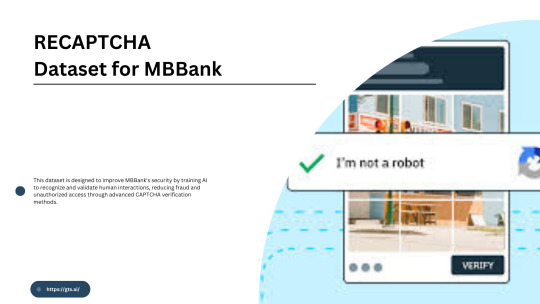
Introduction
In the continuously changing realm of digital banking, the importance of security is paramount for financial institutions. A crucial technology in combating fraud and facilitating secure user interactions is reCAPTCHA. MBBank, a prominent banking entity, has harnessed the capabilities of reCAPTCHA datasets to enhance its cybersecurity infrastructure. This article delves into the RECAPTCHA Dataset for MBBank utilized by MBBank, highlighting its importance and its role in bolstering security within the digital banking sector.
What is the reCAPTCHA Dataset?
reCAPTCHA is a prominent technology created by Google that serves to distinguish between human users and automated bots. It is essential in reducing cyber threats, including automated fraud, credential stuffing, and brute force attacks.
The reCAPTCHA Dataset for MBBank comprises a structured collection of data derived from user interactions with reCAPTCHA systems on MBBank’s online platforms. This dataset encompasses:
User interaction patterns, including mouse movements, clicks, and keystroke dynamics
Challenge-response data, featuring both image and text-based verification
Indicators of bot behavior
Logs of anomalous activities.
Why is the reCAPTCHA Dataset Important for MBBank?
The proliferation of digital banking services has led to a significant increase in security challenges. The reCAPTCHA dataset offers MBBank essential insights into:
Bot Detection and Prevention – By examining user interaction patterns, MBBank is able to distinguish between genuine users and automated bots attempting unauthorized access.
Fraud Prevention – The identification of suspicious login attempts, irregular transaction patterns, and phishing attacks is enhanced through the analysis of historical reCAPTCHA data.
User Experience Optimization – Gaining insights into how actual users engage with the system aids in improving security measures while maintaining user convenience.
AI-Powered Security Enhancements – By utilizing machine learning algorithms, MBBank can harness the dataset to develop models that proactively predict and address security threats.
Applications of the reCAPTCHA Dataset for MBBank
Advanced Authentication Strategies
MBBank has the opportunity to implement AI-based risk assessment utilizing reCAPTCHA data to establish adaptive authentication protocols. This approach allows users demonstrating typical behavior to encounter fewer verification hurdles, while those exhibiting suspicious activity are subjected to more rigorous scrutiny.
Immediate Threat Identification
Through the ongoing surveillance of the dataset, MBBank can identify and prevent fraudulent login attempts in real time, thereby minimizing the likelihood of account compromises.
Strengthened Transaction Security
By leveraging behavioral insights from the dataset, the bank can identify potentially fraudulent transactions and require additional verification prior to executing high-risk operations.
Enhanced Fraud Analysis
The dataset serves as a comprehensive archive of previous fraud attempts, enabling security teams to review past occurrences and fortify their defensive strategies accordingly.
Automated Cyber Threat Mitigation
With the aid of AI-driven automation, MBBank can create systems that promptly address threats by obstructing harmful activities without the need for human intervention.
How to Access the reCAPTCHA Dataset for MBBank?

For individuals seeking to investigate the reCAPTCHA Dataset for MBBank, please proceed to the official download page: Globose Technology Solution.
Conclusion
The reCAPTCHA Dataset for MBBank serves as a significant resource in combating cyber threats within the realm of digital banking. By utilizing this data, MBBank not only fortifies its security measures but also guarantees a smooth user experience. As cyber threats become increasingly sophisticated, the implementation of AI-driven security protocols supported by reCAPTCHA data will be essential for protecting financial transactions and user accounts.
Maintain a competitive edge in cybersecurity—investigate the dataset today!
0 notes
Text
Exploring the Depths: A Comprehensive Underwater Object Detection Dataset

Introduction
The ocean represents a vast and predominantly uncharted territory, concealing innumerable enigmas beneath its waves. Recent advancements in artificial intelligence and computer vision have significantly enhanced our ability to investigate and comprehend underwater ecosystems. A crucial factor in this advancement is the creation of high-quality datasets specifically designed for Underwater Object Detection. These datasets form the essential basis for training AI models capable of identifying and categorizing objects submerged in water, thereby supporting marine research, conservation initiatives, and various commercial endeavors.
The Need for Underwater Object Detection
Underwater settings pose distinct obstacles for object detection. Elements such as limited visibility, fluctuating light conditions, water clarity, and the presence of aquatic organisms complicate the development of reliable AI models. Conventional object detection datasets tailored for terrestrial applications fail to address these specific challenges, highlighting the need for the establishment of specialized datasets for underwater scenarios.
A successful underwater object detection dataset should encompass a wide range of images taken under different water conditions, depths, and environments. Additionally, it must feature labeled objects of interest, including marine species, underwater vehicles, debris, and submerged structures, to facilitate the effective training of AI models.
Introducing the Underwater Object Detection Dataset
The Underwater Object Detection Dataset offers an extensive array of labeled images specifically curated for artificial intelligence training, aimed at tackling the difficulties associated with underwater vision. This dataset serves as an essential resource for researchers, developers, and marine technologists who seek to enhance underwater perception.
Key Features of the Dataset
Varied Image Compilation: The dataset comprises images sourced from a variety of underwater habitats, providing a comprehensive array of scenarios for model development.
Precise Annotations: The objects within the images are meticulously labeled, facilitating the ability of AI models to differentiate among diverse underwater components.
Multi-Condition Imaging: The dataset considers variations in lighting, water clarity, and depth, enhancing the adaptability of AI models to actual underwater environments.
Broad Applications: This dataset is appropriate for applications including marine life observation, underwater robotics, shipwreck investigation, and pollution monitoring.
Applications of Underwater Object Detection
The possible uses of underwater object detection technology are extensive:
Marine Research and Conservation: Artificial intelligence-based object detection assists researchers in examining marine organisms, monitoring endangered species, and assessing underwater ecosystems.
Autonomous Underwater Vehicles (AUVs): AUVs that utilize AI vision technology can traverse underwater settings, circumvent obstacles, and perform underwater assessments.
Pollution Detection and Remediation: AI-enhanced systems are capable of locating and monitoring underwater litter and plastic waste, supporting environmental cleanup initiatives.
Defense and Security: Military and security organizations can employ underwater object detection for surveillance and threat identification in naval operations.
Download the Dataset
For researchers, data scientists, and AI enthusiasts engaged in underwater object detection, this dataset is available for access and offers an opportunity to contribute to the progress of marine technology.
Access the Underwater Object Detection Dataset here: Underwater Globose Technology Solution .
Utilizing high-quality data enables the development of AI models that expand the frontiers of ocean exploration and conservation. Immerse yourself in the realm of underwater AI today and participate in the innovations that are defining the future of marine technology.
0 notes
Text
Real-Time QR Code Detection Using YOLO: A Step-by-Step Guide
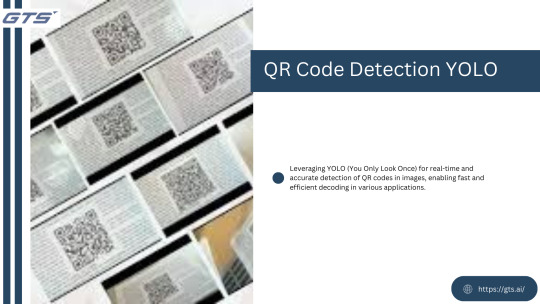
Introduction
Quick Response (QR) codes are everywhere—from product packaging to payment gateways. Detecting them efficiently in real-time is crucial for various applications, such as automated checkout systems, digital payments, and augmented reality. One of the best ways to achieve this is by leveraging YOLO (You Only Look Once), a deep-learning-based object detection model that is both fast and accurate.
In this guide, we will walk through the key steps of using YOLO for real-time QR code detection, explaining the process conceptually without delving into coding details. If you want to get started with a dataset, check out this QR Code Detection YOLO dataset.
Why Use YOLO for QR Code Detection?
YOLO represents an advanced deep learning framework specifically developed for real-time object detection. In contrast to conventional techniques that analyze an image repeatedly, YOLO evaluates the entire image in one go, resulting in exceptional efficiency. The following points illustrate why YOLO is particularly suitable for QR code detection:
Speed: It enables real-time image processing, making it ideal for mobile and embedded systems.
Accuracy: YOLO is capable of identifying small objects, such as QR codes, with remarkable precision.
Flexibility: It can be trained on tailored datasets, facilitating the detection of QR codes across various environments and conditions.
Step-by-Step Guide to Real-Time QR Code Detection Using YOLO
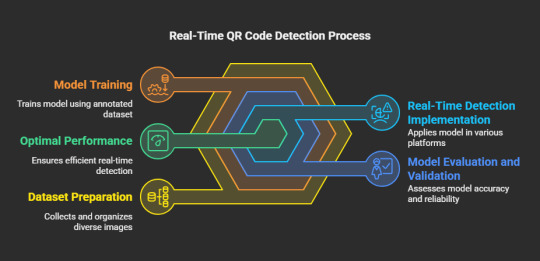
Assemble and Organize the Dataset
The initial phase in training a YOLO model for QR code detection involves the collection of a varied dataset. This dataset must encompass images featuring QR codes under different lighting scenarios, orientations, and backgrounds. You may utilize pre-existing datasets or generate your own by manually capturing images. A well-structured dataset is essential for achieving model precision.
Label the QR Codes
After preparing the dataset, the subsequent step is to annotate it. This process entails marking the QR codes in each image with annotation tools such as LabelImg or Roboflow. The objective is to create bounding boxes around the QR codes, which will act as ground truth data for the model's training.
Train the YOLO Model
To initiate the training of the YOLO model, a deep learning framework such as Darknet, TensorFlow, or PyTorch is required. During the training process, the model acquires the ability to detect QR codes based on the annotated dataset. Important considerations include:
Selecting the appropriate YOLO version (YOLOv4, YOLOv5, or YOLOv8) according to your computational capabilities and accuracy requirements.
Fine-tuning hyperparameters to enhance performance.
Implementing data augmentation techniques to bolster generalization across various conditions.
Evaluate and Validate the Model
Following the training phase, it is imperative to assess the model's performance using previously unseen images. Evaluation metrics such as precision, recall, and mean Average Precision (mAP) are instrumental in gauging the model's effectiveness in detecting QR codes. Should the results indicate a need for improvement, fine-tuning and retraining may enhance the model's accuracy.
Implement the Model for Real-Time Detection
Upon successful validation, the trained YOLO model can be implemented for real-time QR code detection across various platforms, including:
Web applications (for instance, integration with a web camera interface)
Mobile applications (such as QR code scanning features in shopping applications)
Embedded systems (including IoT devices and smart kiosks)
Enhance for Optimal Performance
To ensure efficiency in real-time applications, it is crucial to optimize the model. Strategies may include:
Minimizing model size through quantization and pruning techniques
Leveraging hardware acceleration via GPUs or TPUs
Utilizing efficient inference engines like TensorRT or OpenVINO .These measures contribute to seamless and rapid QR code detection.
Final Thoughts
Real-time detection of QR codes utilizing YOLO represents an effective method that merges rapidity with precision. By adhering to the aforementioned steps—data gathering, annotation, training, validation, and deployment—you can create a resilient QR code detection system customized to your requirements. Whether your project involves a mobile application, an automated payment solution, or an intelligent retail system, YOLO provides a dependable technique to improve QR code recognition in practical scenarios. With Globose Technology Solution, you can further enhance your development process and leverage advanced technologies for better performance.
For an accessible dataset, consider exploring the QR Code Detection YOLO Dataset. Wishing you success in your development endeavors!
0 notes